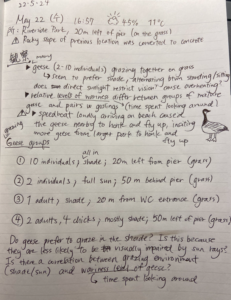I plan on studying the behaviour of the Canada goose (Branta canadensis), which are abundant in my study area of choice, Riverside Park to the south of the Thompson River in Kamloops, BC. Specifically, I noticed that most geese seemed to predominantly stay in the shade while grazing on the grass, despite there being large patches of sunlight shining through the trees. I observed 4 different groups of geese of varying sizes (1 to 10 individuals), 3 of which were situated in the shade. The environment of the park is largely homogenous, with lawns dotted by tall trees and picnic benches.
There are several possible explanations for geese’s seeming preference for shade, such as:
- In order to avoid overheating
- More succulent foodstuff available
- Less likely to be visually impaired by sun’s direct rays
Of these three, I decided that the last is easiest to study (as I cannot measure geese body temperature nor readily identify lawn plants). This can be done by observing for ‘wariness level,’ or the time they spend looking around, as a proxy. My hypothesis is that geese prefer to graze in the shade as they are less likely to be blinded to their surroundings by the sun’s rays. My prediction is that geese will spend less time on alert to their environment while grazing in the shade as opposed to when they are grazing in full sunlight.
The response variable would be wariness level of the geese (or the amount of time/number of geese looking around), which is continuous. The explanatory variable is the environment they are grazing in (shade or sunlight), which is categorical.
Below is my field notebook entry when I observed group of geese and their grazing preferences.

the first thought was perhaps the grass under the trees contains more moisture (reason #2) – I don’t actually know; just a guess!
it might be hard to measure how often a geese is ‘wary’, since that is a human emotion.
I think there are other factors re concern about predators etc – size of flock, how far they can see, proximity to ‘predators’ (including humans, if they have young) etc
it may be possible to do a short behaviour type study although the predictor isn’t super clear
check the literature to see if there is any related literature or behaviour information on this first